May 30th, 2009
Another interesting plant that’s been floating around the hobby for a few years now is known as Rotala sp. ‘Mini – Type 1’. There are two plants going around as R. sp. ‘Mini’, so people refer to them as Type 1 and Type 2. The Type 1, shown below is a very petite stem plant with unique leaves that curve downward toward the substrate. The leaves can also get a nice gradient of orange and reddish tones under certain conditions.
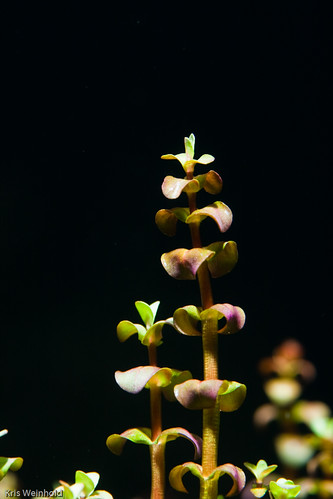
In my opinion, this is a plant that is quite ugly individually, but as a large bush (50-100 stems) is incredibly striking because there aren’t many plants that look like it. The relatively vertical nature of its growth defines the interesting group-of-quills look of the bush. Rotala sp. ‘Mini – Type 1’ demands a little bit more attention (light, CO2, nutrients) than the easier Rotala species, but is still not too difficult to keep. Give it a try!
Posted in Plant Profiles | Comments Off on Rotala sp. ‘Mini’ – Type 1
May 28th, 2009
Sphaerocaryum malaccense is one of the newer plants in the hobby that was originally traded erroneously as Arthraxon sp. ‘Malaysia’. Native throughout much of Asia, S. malaccense grows in swampy conditions forming loose mats of vegetation. In the aquarium, it is a very unique aquatic grass with leaves looking like trowels protruding from the stem via a sheath.
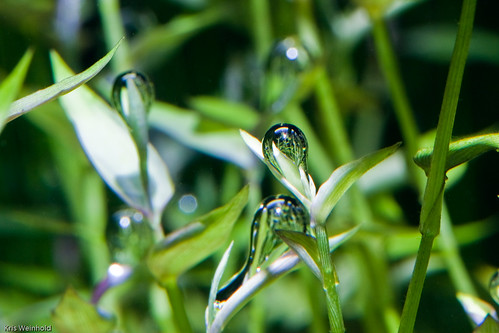
In a large group, Sphaerocaryum malaccense forms a nice bush, but doesn’t seem to form as tight a bush as a plant such as Rotala rotundifolia. It seems to grow well in medium light with CO2, but can really take off in higher light conditions. I’ve seen it grown successfully in some dosing and soil-based tanks, so it should grow in most situations.
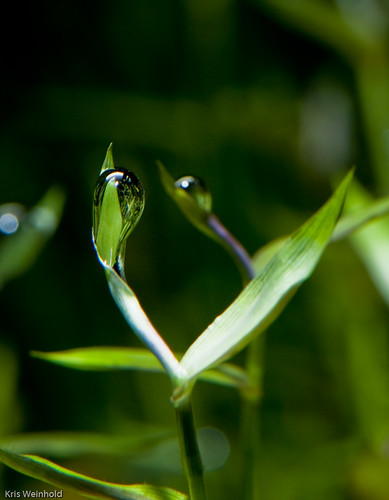
When doing well, my friend Dave has observed that it pearls more than most other plants in his aquarium, with the oxygen bubbles get trapped in the curves of the leaves. Under high light, the leaves can get reddish brown highlights, but some green still remains. Overall, due to the unique aesthetic and relative ease of keeping, Sphaerocaryum malaccense is an exciting new plant to grow and aquascape with.
Posted in Plant Profiles | 4 Comments »
May 21st, 2009
After doing my last 2.5G aquascape with Riccia fluitans, I decided to try it again with some leftover Riccia, but this time, also use Blyxa japonica as a grassy background plant. Please ignore the unnaturally white patch in the front-center as some of this Riccia had been sitting in a container away from light for a week or two. Opps!

I’m really enjoying some of this slate that I found last month with a couple of GWAPA members. We found some pieces with pretty good character, which make it perfect for a small tank like this. In any case, in scape with just two plants, there’s not much to say. What do you think? Comments/critiques welcome!
Posted in 2.5G Tank Log | 5 Comments »
May 17th, 2009
I wanted to provide an update for my 54G native fish and plant aquarium. I have, however, broken my own rules for this aquarium to help it mature a little bit. I added some non-native floating plants to the surface temporarily, to help soak up some of the excess nitrate from the aquasoil. In doing so, the algae on the hairgrass and the rest of the plants is almost entirely gone. As you can see, that’s not quite the case for the rocks though.
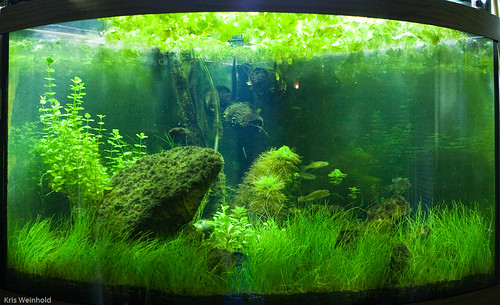
The rocks are completely covered in black brush algae, but I have increased the CO2 output and have refined my dosing routine, so I’m confident that it’s just a matter of time before I’m able to get rid of it. I will likely end up manually scrubbing the rocks at the next water change, and then let my adjustments do the rest.
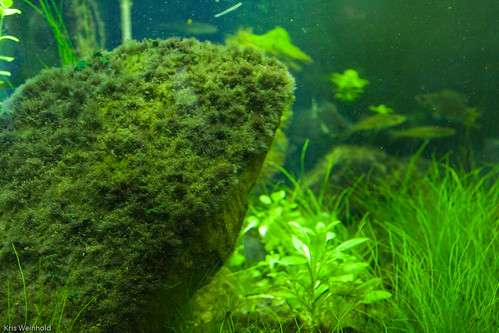
The fish are all doing very well, kept happy with a healthy diet of blackworms, and a few extra pellets when they’ll accept them. I still haven’t seen any spawning behavior, but I don’t really expect to see much of that since I didn’t chill these fish over the winter. They’re probably wondering why their summer has lasted 9 months!

All in all, I’m very pleased with the direction of this tank. I will soon be able to collect some more native plants to fill out the background. After that, I’ll focus a little bit more of the aquascape itself. Comments welcome!
Posted in 54G Tank Log | 3 Comments »
May 11th, 2009
It was a beautiful day on Sunday, which I spent most of the day planting our garden. I was working around my raised brick pond, and I spotted this little tree frog. I’ve had several frogs visit our yard and pond over the years, but I’m not sure I’ve seen this one before.
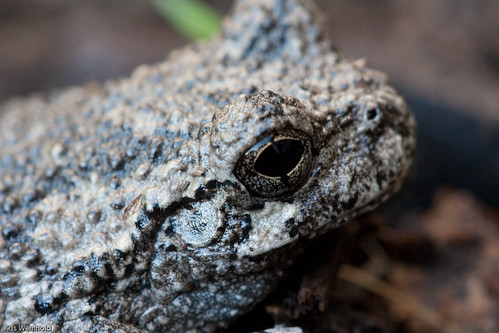
I immediately snapped a few pictures, (I needed a break from moving dirt anyways), and sent them to my GWAPA friend and local frog expert, Corey, to identify. She tells me that it’s definitely a grey tree-frog, and from its black throat, she can tell its a male who’s been calling lately. Species-wise, it’s likely either Hyla chrysoscelis or Hyla versicolor, which are indistinguishable from one another except by their call. Thanks Corey!
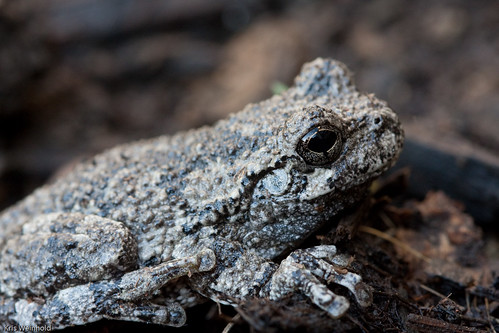
It wasn’t able to get a picture of it, but when this guy hopped, he had bright orange splotches on the inside of his is thighs, which are used to startle predators. Corey says that this particular species can make a great pet, which I’m not planning on doing, but will be more than happy to see him around my pond throughout the summer.
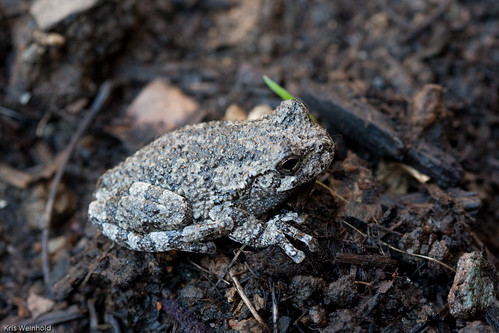
Hopefully, he’ll bring some of his other amphibian friends, and I’ll have a pond full of interesting wildlife.
Posted in Raised Brick Pond | 3 Comments »
May 7th, 2009
I’ve recently obtained two completely different plants with “Sunset” in their names. The first is Cryptocoryne wendtii var. ‘Florida Sunset,’ which was just introduced last year at the Aquatic Gardener’s Association convention by Florida Aquatic Nurseries (FAN). FAN is the U.S.’s largest supplier of aquatic plants, so you should be able to obtain this plant through your local aquarium retailer.

This variety is named for the extreme varigation present in the leaves. Unfortunately, so far for me, the submersed leaves resemble regular Cryptocoryne wendtii in coloration. In my picture above you can see the varigation in one of the taller, decaying terrestial leaves with green, orange, and red all present.
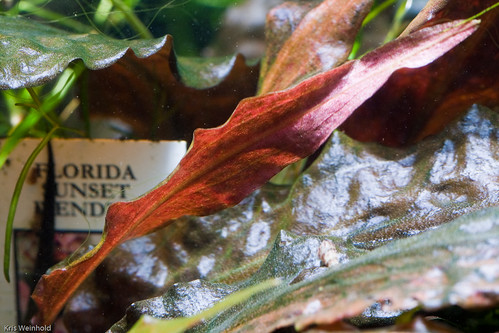
The next plant is known as Rotala sp. ‘Sunset’, and is far more rare in the U.S. Apparently, it’s more readily available in Japan, but I only know that from heresay. This plant is a rather beautiful stem plant exhibiting oblong red leaves with attractive veining, similar to Rotala ramosior. The green stem provides a very nice contrast.

So far it hasn’t been as fast a grower as some other Rotalas, but hasn’t been glacial either. It seems to branch readily, and grows vertically toward to the light. I think it has a lot of potential to be a great aquascaping plant, as a small group could be a fantastic accent plant.
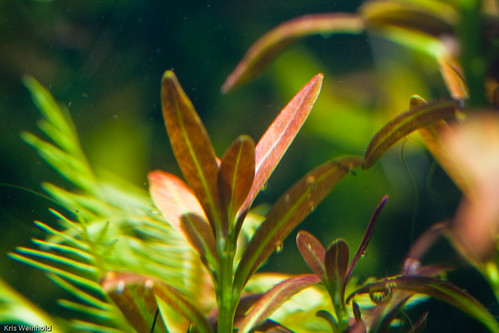
I recommend both of these plants to anyone. Obviously, the Cryptocoryne is more suitable to a wider array of tank conditions, but the Rotala should grow for medium-high light tanks, with CO2 being highly preferred. I have only grown it in high-light with CO2, so I cannot fully vouch for grow in other conditions. If anyone else has kept these plants, please feel free to share your feedback.
Posted in Plant Profiles | Comments Off on Crypt and Rotala Sunset
May 3rd, 2009
After looking at the last aquascape, and sleeping on it overnight, I decided to change a few of the rocks in front. Let me know what you think…
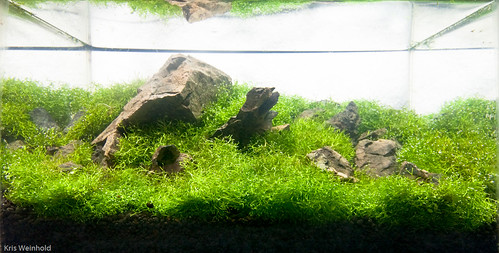
Posted in 2.5G Tank Log | 6 Comments »
May 2nd, 2009
GWAPA’s 2.5G aquascaping contest is well underway, and I wanted to try my hand at a riccia rockscape as it would be quick to put together, and would hopefully get me used to working inside this small of an aquarium. So, I looked through my “rock box” for some smallish pieces of rock, built up a slope, and then covered the whole substrate with Riccia fluitans, which I had been growing out for months in my 75G for this very purpose.
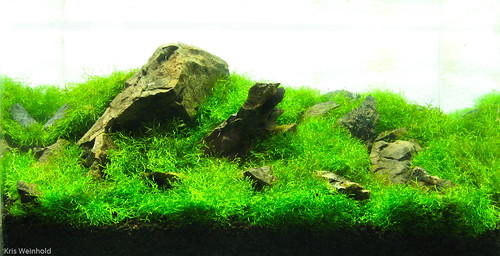
What do you think of the result? It really couldn’t be any easier of an “instant-scape,” as the look is virtually complete immediately after planting. Now only that, but Riccia is a floating plant, so it’s unlikely that all pieces will stay down on the substrate forever, making this a very short-term aquascape.
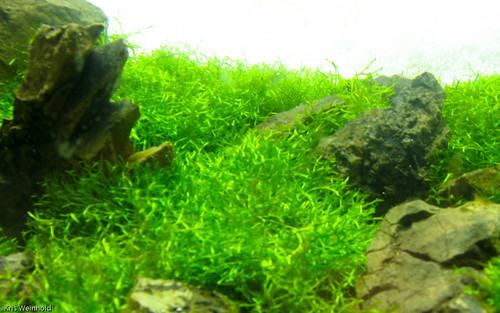
While others have used hairnets, fishing line, string, and other implements to keep the Riccia inplace, I started with large mats of Riccia, so all I needed to do was hold down the center with strategitically placed rocks. That’s the benefit of growing it as floating mats in another tank first, before trying to use it as a foreground plant — the mats are already tightly interlocked. Comments/critiques welcome!
Posted in 2.5G Tank Log | 2 Comments »
















